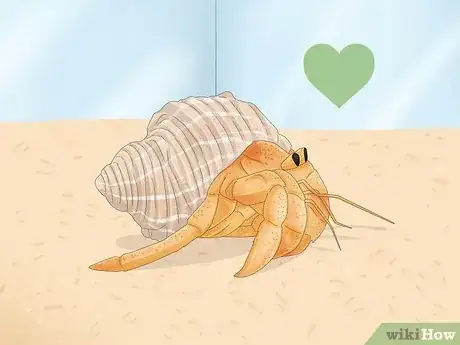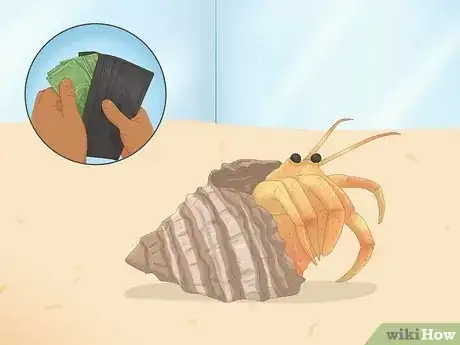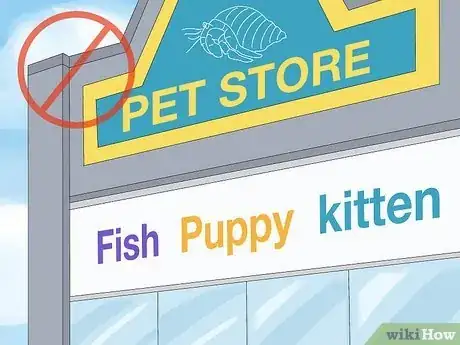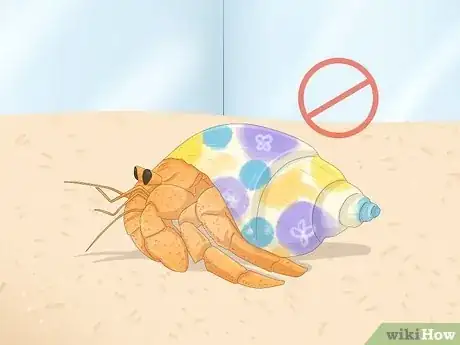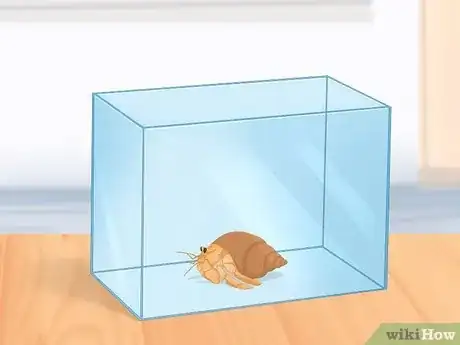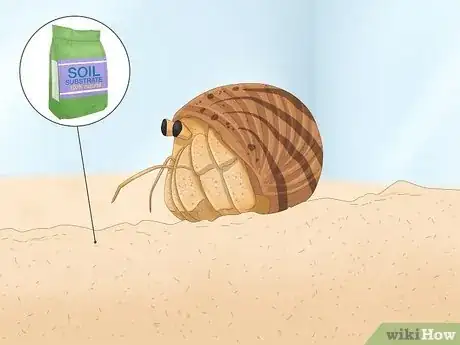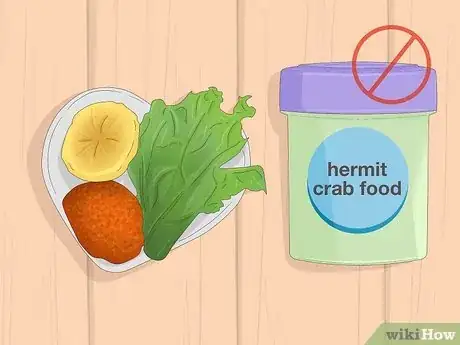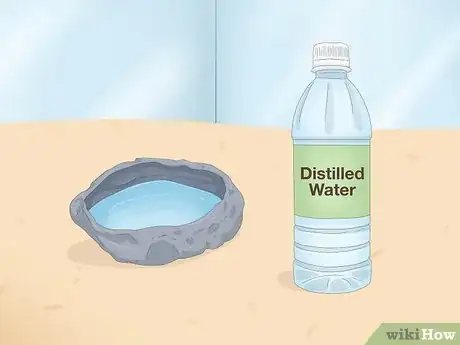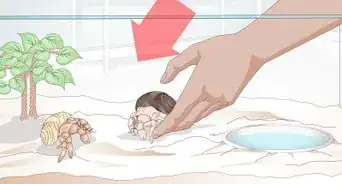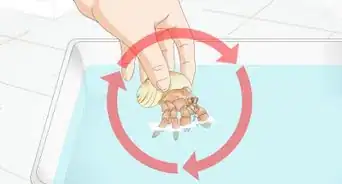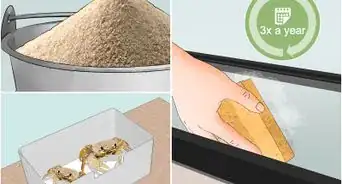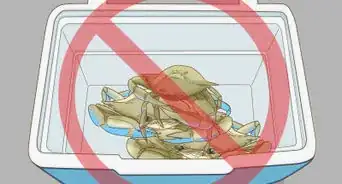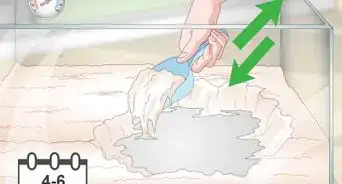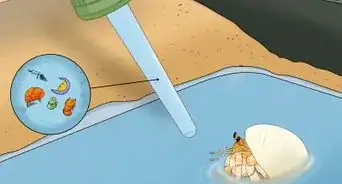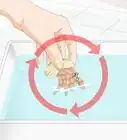This article was co-authored by Pippa Elliott, MRCVS. Dr. Elliott, BVMS, MRCVS is a veterinarian with over 30 years of experience in veterinary surgery and companion animal practice. She graduated from the University of Glasgow in 1987 with a degree in veterinary medicine and surgery. She has worked at the same animal clinic in her hometown for over 20 years.
There are 9 references cited in this article, which can be found at the bottom of the page.
This article has been viewed 44,696 times.
Hermit crabs are difficult to obtain ethically. Your best option is to adopt a crab from someone who has raised and cared for a hermit crab. Avoid buying one from a pet store or beach-side souvenir shop, as the crabs in these shops are mistreated and usually unhealthy. Before bringing a hermit crab home, look for signs that it has been treated well and is healthy, and prepare a place for it in your home. Because hermit crabs can be unsatisfactory as pets, think carefully before investing in one.
Steps
Choosing Your Crab
-
1Look for a healthy crab.[1] Crabs that do not come out of their shells when misted might be ill, and should not be purchased. Likewise, if you see tiny crab limbs scattered about a crab’s tank, do not purchase it. This is a sign that the crab is stressed and vulnerable to other illnesses.
- Do not obtain crabs that have a musty smell. This indicates they are overheating.[2]
- Crabs that are active and moving about, and do not exhibit any of the above negative qualities, are probably in good health.
-
2Ensure the crab is housed properly. Crabs should be housed in an environment where they can dig in the sand, move around, and hide. Do not buy crabs that are crammed in tiny individual cages where they cannot move.[3]
- Ask what kind of water the crabs have access to. Crabs need both fresh water and salt water, and should have one bowl with each. Crabs that are in tanks with tap water, however, will be slowly poisoned over time.
- Do not obtain crabs that are housed in tanks with flies and other bugs buzzing about.
Advertisement -
3Think about alternatives to buying a hermit crab. Buying a hermit crab only fuels the cruel hermit crab trade that profits from their capture and sale. Instead of buying a hermie, try adoption. The Hermit Crab Association (HCA) connects sanctuaries and crab rescue agencies with people who want to care for a hermit crab.[4] You need not be an HCA member to adopt a crab, but you may need to pay a small fee for the adoption service.
- Send an email to adoptions@hermitcrabassociation.com expressing your interest in adopting a hermit crab for more information.
- In your email, include your location and how far you would be willing to travel to obtain your crab.
-
4Be sure you are ready for the commitment before buying. Hermit crabs are not toys, decorations, or temporary distractions. They are living creatures with particular preferences and needs. Over the long term, they can also be expensive. You’ll need $300-$500 in setup costs alone, including a tank filter, companion crabs, and so on.
- Hermies can live up to 40 years. Ask yourself if you’re willing to care for your crab that long.
- Think carefully before purchasing a hermie for a child. Children tend to lose interest quickly in hermit crabs since they have a tendency to hide under their tank’s substrate for weeks at a time.
-
5Do not buy a hermit crab from a pet store.[5] Pet stores and beach souvenir shops care little about the health and happiness of their crabs, and cram them tightly together for shipment in conditions where the crabs cannot access food or water. Pet shops care only about getting the crabs to the store, no matter what condition they are in, since consumers are often not equipped to evaluate the health of a crab based on how it looks.
-
6Do not buy a crab with a painted shell. Crabs in painted shells have been forcibly removed from their natural shell and crammed into new shells that might not accommodate them properly. This can cause the crab tremendous stress. Crabs in painted shells are also at risk for being poisoned if they eat paint chips from their painted shells. If the paint inside the shell didn’t dry properly before the crab was jammed into it, the crab might be trapped when the paint dries against it.
Making Your Crab Comfortable
-
1Quarantine your hermit crab, if possible. If you’re introducing a new crab to another crab, or a whole population of other crabs, you should place it in a separate tank for a few weeks. That way, if your crab has parasites or other illnesses, they won’t spread to your other crabs.
- However, many hermie owners simply rinse their hermies in a quick freshwater bath and add them straight into the main crab population, since isolating a hermit crab in a quarantine tank can have negative effects on your crab’s health.
- Weigh your options carefully before deciding to quarantine your crab.
-
2Choose the right tank. When it comes to tanks, the bigger the better. Since hermit crabs are very social creatures, you should have at least two or three small crabs together in a single tank. A population of this size will not be comfortable in anything less than a 10 gallon (37.9 L) glass aquarium.
- If your crabs are immature, be sure to invest in a tank larger than 10 gallons (37.9 L), since the crabs will grow.
- Hermit crabs are excellent climbers. Keep a mesh lid on your tank to prevent your hermies from climbing out. This will also prevent gnats, mites, and other bugs from getting in and hurting your crabs.
-
3Install a substrate. Crabs need a natural substrate to dig and hide in. Use all-purpose sand (the type you’d fill a child’s sandbox with) or coconut fiber. Fill the tank with substrate to a level two to four times higher than your largest crab.
- For instance, if your tallest crab is three inches tall, your substrate should be six to twelve inches deep.
- All-purpose sand is available at your local hardware store.
- Coconut fiber might be available at some pet stores, but you can order it easily online.
- If you wish, you can mix the sand and coconut fiber substrate together. Some hermie owners find that their crabs like this mixture best.
- Always wet your substrate until it feels like the sand that has just had the tide wash over it. Use a plastic spray bottle to keep the substrate damp. Do not use dry substrate, as this won’t allow your crab to dig, and can dehydrate your crab.
- Do not use wood chips, gravel, reptile sand, or special hermit crab sand. Additionally, do not use any kind of artificially dyed or chemically treated substrate.
-
4Maintain your tank’s climate. The tank should be at least 75 degrees Fahrenheit (24 degrees Celsius).[6] Install a thermometer in the tank so you can always quickly check what the tank’s temperature is. If you have a hard time keeping the tank hot enough, place it near a window or invest in an under-tank heater to keep your tank warm.
- Additionally, the humidity should be at least 70%. Invest in a hygrometer to measure the tank’s humidity levels.
- If you need to increase your tank’s humidity, just spray the substrate a few times with a water bottle. Check it after 30 minutes or so to see how the humidity level has adjusted. Spray again if necessary.
- Many hygrometers also have built-in thermometers.
- Under-tank heaters are available at most pet stores.
Caring for Your Crab
-
1Feed your crab. Hermies eat almost anything. Dried shrimp, sardines, and seaweed are common hermit crab foods. Fruits, vegetables, and nuts are also favored. Some human foods like cereal, oatmeal, or popcorn are acceptable, as well.[7] Feed your hermies a variety of foods and see what they like best.
- Do not feed your crab anything labeled “hermit crab food.” These pet store mixes do not have the adequate nutritional profile a healthy hermie needs.
- Other foods to avoid include garlic, onions, citrus fruits and peels, and anything with added sugars, chemicals, iodized salt, and preservatives.
- Fresh food should be removed every day. Dry food should be removed as needed, but don’t leave it in the tank longer than four days. Food that is still in the tank after four days is probably just not palatable for your crabs.
-
2Provide water. Hermit crabs need both freshwater and saltwater.[8] Both types of water must be free of chlorine and chloramines. The temperature of the water should be approximately the same temperature as the temperature of the tank. When mixing saltwater, do not use salt mixes labeled for hermit crabs. Instead, use a non-iodized fish salt, and mix it according to the instructions on the package. Place the saltwater and freshwater in two separate bowls with the rims parallel to the topmost layer of substrate.
- Distilled or bottled water are the best options for providing your crab with freshwater.
- If necessary, invest in a dechlorinator. These are usually available at pet stores or home and garden stores.
- The amount of water you need depends on how many crabs you have. A five to six cup bowl of each type of water should be adequate for two to three small crabs in a 10 gallon tank.
-
3Provide a variety of shells for your hermit crab. As hermit crabs grow, they need to change shells. Hermit crabs are always looking to trade up their current shell for one that is smoother on the inside, or one that is of a lighter weight. There are a wide variety of both natural and synthetic shells available. You can buy shells online and at pet stores.
- If you obtain a synthetic shell, be sure it is not painted or treated with any chemicals.
Warnings
- Never lift your crab up to a high elevation. Always hold it over the substrate.⧼thumbs_response⧽
- Hermit crabs have claws and will pinch if frightened. Hold your hand flat if you want to pick it up.⧼thumbs_response⧽
- Hermies can and will climb out of any container without a lid.⧼thumbs_response⧽
- Never pull a crab out of its shell, off of something it’s clinging too, or pull it up from beneath the substrate.[9]⧼thumbs_response⧽
References
- ↑ http://www.dailymail.co.uk/news/article-3692013/Pet-store-supplier-opens-shells-live-crabs-force-smaller-ones-forcing-cramped-cages-dying-crustaceans-Horrifying-PETA-video-shows-think-twice-buying-hermit-crab-souvenir-beach-shop.html
- ↑ http://www.hermit-crabs.com/FAQ.html
- ↑ http://www.nytimes.com/2016/05/08/opinion/sunday/is-your-pet-lonely-and-bored.html?_r=1&mtrref=undefined&assetType=opinion
- ↑ http://hermitcrabassociation.com/pages/adoptions.html
- ↑ http://www.dailymail.co.uk/news/article-3692013/Pet-store-supplier-opens-shells-live-crabs-force-smaller-ones-forcing-cramped-cages-dying-crustaceans-Horrifying-PETA-video-shows-think-twice-buying-hermit-crab-souvenir-beach-shop.html
- ↑ http://www.hermit-crabs.com/care.html
- ↑ http://sciencecafe.org/content/faq-about-hermit-crabs/
- ↑ http://hermitcrabassociation.com/phpBB/viewtopic.php?f=25&t=92553
- ↑ http://www.plightofthehermies.org/adopt/
About This Article
Before buying a hermit crab, make sure you’re ready for the time and monetary commitment since they can live up to 40 years and can cost a few hundred dollars in setup costs alone. If you’re still interested in getting a hermit crab, look for one that is active and comes out of its shell, which are signs that it’s healthy. Additionally, look for a crab that have been housed properly, with access to both salt and freshwater. You'll also want a crab that's had sand for digging in and space to move around and hide. For more tips from our Veterinary co-author, like how to decide if you should buy or adopt a hermit crab, keep reading!
